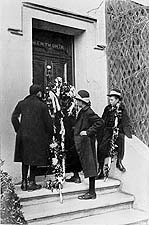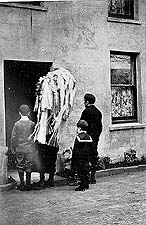

Hunt the Wren (Ramsey 1904)
Hunt the Wren (Douglas 1904)
[From Birds of the IoM, 1905]
JINNIE, JINNIE WRAN. Manx, *Drein, Drean (M. S. D. and Cr.); Dreeain (M. S. D.). (Cf. Irish, Dreathan, Dreoilin; Se. Gaelic, Dreollan, Drethein.)
Without being really numerous, the Wren is common and well distributed in Man. Its haunts are very varied, a certain amount of shelter alone being essential, and the hardy little bird is at home among the heather and brambles overhanging the course of the mountain stream
Since this was first written the Blue Tit has become quite frequent in Castletown, and may be seen every day in the gardens and on the trees planted on the Parade, through the rocky ravine, amidst the boulders and bracken of the rough hillside, and in the rock-fissures of the wild coast, as well as in the neglected garden hedge with its mossy hawthorn stumps, or the farm-steading, where in winter it finds its food. A steep, shaded, and overhung bank is perhaps its favourite home.
In August 1881 Mr. Graves found a nest at Crosby with four fresh eggs. He has been told by Mr. W. J. Clague that for twelve consecutive years there was a nest in a hole by the lintel near the back door of his house at Ballabeg. Mr. Kermode mentions a white specimen at Tholt-e-Will in 1899.
A Wren is noted at Langness lighthouse, 10th March 1885, another on 22nd April 1886, and four or five Wrens, 17th October 1885 ; while large flocks of migrants reported from the Chickens from 8th to 12th of same month are stated to have been partly composed of this species (?).
The quaint personality of the Wren is with us associated with the curious celebration on 26th December, for a more detailed discussion of which the reader may be referred to Mr, Moore's Folk-Lore of the Isle of Man, p. 133, et seq. I will only quote the brief account (there copied from Manx Society, vol. xxi. [sic xvi p151]) by the late William Harrison.
' This custom is still kept upon St. Stephen's day, chiefly by boys, who at early dawn' sally out armed with long sticks, beating the bushes until they find one of these birds, when they commence the chase with great shoutings, following it from bush to bush, and when killed it is suspended in a garland of ribbons, flowers, and evergreens. The procession then commences, carrying that " King of Birds" as the Druids called it, from house to house, soliciting contributions, and giving a feather for luck. These are considered an effectual preservative from shipwreck, and some fishermen will not venture out to sea without having, first provided themselves with a few of these feathers to ensure their safe return. The " dreain " or Wren's feathers are considered an effectual preservative against witchcraft. It was formerly the custom in the evening to inter the naked body with great solemnity in a secluded corner of the churchyard, and conclude the evening with wrestling and all manner of sports.'
During the last thirty years the performers have been more frequently without the Wren than otherwise, it no doubt being found that tender-hearted householders refused their contributions to parties with a dead bird. The custom, which at the commencement of that period was universal throughout the isle, has now to some extent died out, and had lost many of its peculiar features.
Yet the writer, in passing through Onchan on the morning of 26th December 1903, saw no fewer than five 'Hunt the Wrens' in that village, and in 1902 they were quite numerous in Douglas. As the result of more particular inquiries in 1904, he finds that there were in that year many parties in Douglas, and some also at Peel, Port St. Mary, and Kirk Michael. At Ramsey Mr. Cowen thinks the custom almost extinct, and the little party photographed by him the only one. At Castletown there were about four.
|
|
|
|
Hunt the Wren (Ramsey 1904) |
Hunt the Wren (Douglas 1904) |
The doggerel verses, always sung in English within the writer's recollection, and it would seem for long before, will be found, with the air to which they are sung, in Mr. Moore's above-cited work, also in his Manx Ballads, pp. 64, 252, and arranged in Mr. W. H. Gill's Manx National Songs, p. 62. For comparison with the observance corresponding in France, Ireland, and Wales, compare Yarrell, 4th ed., i. 465, Rolland, Faune Populaire, ii. 295. Its origin is quite unknown; the words sung here are doubtless comparatively modern.
The following folk-lore tale about the Wren is given by Mr. C. Roeder in Isle of Man Examiner, 5th April 1902
YN DR.EAN (THE WREN).
'(81) Keayrt dy row va ny ushaayn chaglym dy boiljaghey da y chooilley ere obbraghyn va'd son yannoo. Va'd loayrt unnane eck cheayrt, ginsh guoid dy eean va'd troggal, as ere cha mie va'd laboragh. Tra haink yu drean beg dy nish ere foddagh ee jannoo, dooyrt ee
"Myr s'beg mee hene, myr keyl my chass,
Un ecan jeig ver ym lesh ass."
'The birds all met together once upon a time to tell of all the great things they could do. They were speaking one at a time, saying how many young, they were rearing, and how good they were labouring,. When the little wren came to tell what he could do, he said
Though I am light and my leg is small
Eleven chicks I bring out for all."
That's what the old people were saying.'
The well-known folk-tale about the Wren obtaining the kingdom of the birds by mounting above the Eagle in flight was, Miss Morrison writes me, told her by an old woman who had it from her mother in Manx.
The Wren is common all over the British Isles, extending over to the most remote, as Foula and St. Kilda. The form occurring in the latter is by some considered specifically distinct.
1 Townley (1789) says: 'If they can catch or kill the poor Wren before sunrising, they firmly believe that it ensures a good herring fishing the next season.' (Vol. i. P. 311.)
|
|
||
|
|
||
|
Any comments, errors or omissions
gratefully received The
Editor |
||